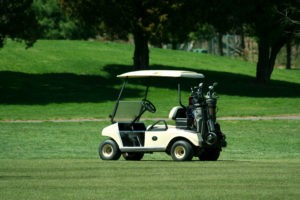As you travel around The Villages, one of the first things you will notice is the way people travel. It is possible to live, shop and play in The Villages without having to own and maintain a car. With cars, golf carts, and bicycles sharing the roads, safety is important for the drivers and passengers in all vehicles, especially for bicycles and golf carts.
Golf Cart Laws in Florida

The first rule of golf cart safety is to know where you may legally drive one in the state of Florida. Florida law governs where golf carts may be driven in the state:
Golf carts are not allowed on interstate highways, or on any roads with speed limits over 35 mph.
State roads with speed limits of 35 mph or less may be designated for golf cart use.
Golf carts may crossroads when a golf course is on either side of the road, in designated crossing areas only. Golf carts are allowed on private roads with the permission of the owner.
Florida law also restricts golf cart use to the hours between sunrise and sunset, unless a local governing authority authorizes their use after sunset. Golf carts operating after sunset must have headlights, brake lights, turn signals, and a windshield.
Children under the age of 14 may not drive a golf cart.
Local governments may permit golf carts to operate on sidewalks if the sidewalks are more than eight feet wide, if the speed limit is restricted to 15 mph or less, and appropriate signs are posted to notify pedestrians that golf cart use is permitted.
The maximum speed allowed on a golf cart is 20mph. Owners are not allowed to legally modify golf carts to exceed 20mph, and doing so may void insurance coverage in the event of an accident.
Florida law prohibits driving a golf cart while intoxicated, and the penalties are the same as for driving a motor vehicle while intoxicated. While a driver’s license is not required to operate a golf cart, a conviction for DUI in a golf cart can lead to loss of one’s license to drive a car.
Golf carts on any public roads must obey all traffic ordinances, such as stop lights, yielding to pedestrians, and proper turn signaling.
In The Villages, golf cart lanes are often marked with a diamond pattern; if there is no marling, golf carts should be driven on the far right side of the street.
Golf Cart Safety Equipment
Windshields are only required for golf carts operating between the hours of sunset and sunrise but can be an important safety feature. Windshields can protect drivers and passengers from stray golf balls, and from other objects thrown up from the road by cars, bicycles, or other carts.
- Seat belts are not required but can protect riders if sudden braking is necessary.
- Required for nighttime use, turn signals and brake lights are also helpful when driving on the streets in The Villages.
- Reflective devices on the front, rear, and sides of the cart will help prevent collisions.
Common Golf Cart Accidents
- Collisions with other golf carts, pedestrians, bicyclists, or cars.
- Ejection from a golf cart after sudden braking.
- Overturning the golf cart in uneven terrain.
- Striking or running over pedestrians.
- Falling out of a golf cart while standing.
Golf Cart Safety Tips
- Always obey all traffic regulations and posted signs.
- Do not modify your golf cart to exceed the legal speed limits.
- Do not stand or allow passengers to stand in the golf cart.
- Always signal before turning; use hand signals if your cart is not equipped with electric signals.
- Take advantage of the golf cart safety classes offered at The Villages.
Bicycle Laws in Florida
Ironically, bicycles are allowed on more public roadways in Florida than golf carts. Bicycles are allowed on all Florida roads except interstate highways and limited access highways.
Bicycles must obey all traffic signals, and must travel in the same designated lanes as cars.
Bicycles traveling at a lower rate of speed than surrounding traffic must ride on a designated bike lane, or as close to the right of the roadways as possible, except when avoiding another vehicle, or when the lane does not allow enough room for a bicycle and another vehicle to travel safely side-by-side.
Cyclists may not ride two abreast, and may not wear headphones or other listening devices.
Bicycle Safety Equipment
Bicyclists are not required to wear helmets in Florida, but wearing a helmet is the best way to prevent or reduce the likelihood of serious head injuries.
- Reflectors on the front, rear and sides of the bicycle are essential when riding at night.
- A headlamp is also a necessary piece of safety gear for nighttime riding.
- A horn or bell will alert other drivers of your presence.
- Bright clothing is recommended, especially for evening riding.
Florida Bicycle and Golf Cart Safety Tips
- Always obey traffic regulations and signs.
- Wear a helmet at all times.
- Do not ride with more people than the bicycle was designed to carry,
- Do not wear headphones or listening devices.
- Avoid cell phone use.
- Remember that the drivers of motor vehicles may not be on the lookout for bicyclists.
- Do not ride while impaired.
- Although Florida law does not require riders to keep at least on hand on the handlebars, doing so is highly recommended.
- Keep a water bottle on your bike or in a backpack when riding in hot weather, or on long rides.
- Sign up for one of the bicycle safety classes offered at The Villages.


